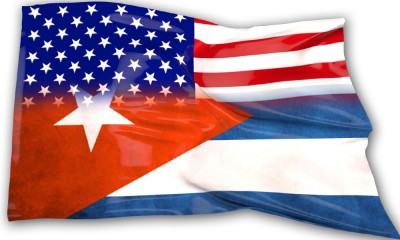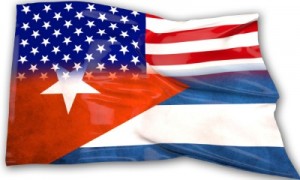
The Cuban-American enclave in Miami
HAVANA – Sixty-seven percent (1.02 million) of all Cuban-Americans live in the state of Florida, the Latin group with the largest geographical concentration in the United States.
This degree of concentration is even more remarkable when you realize that 48 percent (856,000) live in Miami-Dade County, home to the so-called “Cuban-American enclave.”

Add to this the fact that many of them live in the counties adjacent to Miami, spreading their cultural peculiarities to those territories. [1]
Another characteristic of the Cuban-American enclave is that, rather than disperse as normally occurs during the process of integration, the immigrants tend to attract people of Cuban origin living in other places.
We can assume that the fundamental attraction lies in the culture, since the statistics show that those who live outside the enclave earn proportionally greater income. [2]
Although they constitute 6.5 percent of the state’s population, Cuban-Americans represent 34 percent of the population of Miami-Dade County and 60 percent of the county’s Latin population.
Such a demographic composition places Miami as the nation’s third-largest city in the number of its immigrants, after Los Angeles and New York, and the only major U.S. city inhabited by a majority of people of Latin American provenance.
Miami’s economic base depends basically on the foreign market, tourism and commercial and financial services to Latin America. Fifty percent of Florida’s foreign trade is generated in Miami, and 90 percent of U.S. shipments to the subcontinent goes through Miami’s ports and airports.
Miami International Airport is the main hub for air travel between the U.S., Latin America and western Europe and ranks third, behind Hong Kong and Tokyo, in the transportation of merchandise.
One third of the nation’s most important Hispanic companies are concentrated in Miami. About 200 multinational corporations maintain their Latin American offices in the area. The United States’ leadership in the field of new information technology increases Miami’s competitiveness in that sphere, as Miami is capable of offering that service in two languages.
Besides, Miami provides direct access to commercial and financial information relative to the markets that interact in the city, which propitiates the concentration of the largest number of international banks in the United States.
Miami’s ability to provide U.S. banking services in Spanish has helped attract much of the private capital that emigrates from Latin America in search of security and higher profits. The lassitude in the handling of these funds that has characterized Miami’s banking system has contributed to Miami’s comparative advantage as a financial intermediary between Latin America and the United States.
And these banks compete for the local Hispanic market, which is considered to be the United States’ third richest.
Latin American tourism also sees Miami as one of its main destination points. Generally, it consists of tourists with high purchasing power, whose purchases in the local market have helped South Florida become the area with the largest growth of major commercial centers in the United States.
Considering all this data, marketing studies done by specialists at Madrid’s Complutense University attribute Miami’s economic boom to the county’s cultural characteristics, especially bilingualism. Their opinion is that, while tariffs and other legal obstacles can be eliminated by administrative measures, this cannot be done with the cultural barriers that make the commercial process more expensive and difficult.
This is particularly true in the entertainment industry and, according to them, explains why Miami has become what’s called the new “Latin Hollywood.” [3]
The main headquarters of Univisión and Telemundo, the largest Hispanic TV networks, are situated in Miami, as well as the operational centers of the main U.S. TV channels, which broadcast to Latin America via satellite. Consequently, Miami has replaced New York City as the nation’s second most important Hispanic advertising market, behind Los Angeles.
The existence of this Hispanic entertainment industry emphasizes Miami’s Latin profile, as well as the predominant role of Cuban-Americans in its operation, even though neither the artists nor the main capital are primarily Cuban-American.
The role of Cuban-Americans is also strong in areas as sensitive as the TV information media, where they have come to control much of the productive process in networks as important as CNN en Español, even though that network’s main offices are in Atlanta.
Not even Cuba escapes Miami’s commerce with Latin America. A little-studied aspect is the impact of the Cuban market in Miami’s economy, specifically in the Cuban-American enclave. The charter airlines and the travel agencies to Cuba have created a network of establishments that has survived all the avatars of the conflict between the two countries.
A multitude of stores and pharmacies exist thanks to the demand from Cuba and many companies handle the shipment of goods and money to the island. The business of “maleteros” – travelers who carry the goods – involves hundreds of individuals and has created an informal market with cultural characteristics so peculiar that it has become part of the “social landscape” in both countries.
As a result of the comparative advantages mentioned earlier, Miami has become the center of U.S. trade with Latin America, a platform for the spreading of U.S. culture and ideology into Latin America, and an important international shopping center that specializes in the Latin American market.
Cuban-Americans have contributed much of the human capital that has enabled this development and are the best prepared people to do it, either as managers and professionals or as partners of the companies that generate the development. This has served to project an image that they constitute a “golden exile.” In forthcoming installments of this series, we shall analyze how real that image is.
[1] Data from the PEW Hispanic Center: “Hispanics of Cuban Origin in the United States,” Washington, D.C., June 27, 2012.
[2] Eckstein, Susan Eva: “The Immigrant Divide,” Routledge Publishers, New York, 2009.
[3] Plaza Cerezo, Sergio: “An Economic Analysis of the Hispanic Market in the United States,” Complutense University, Madrid, 2008.


